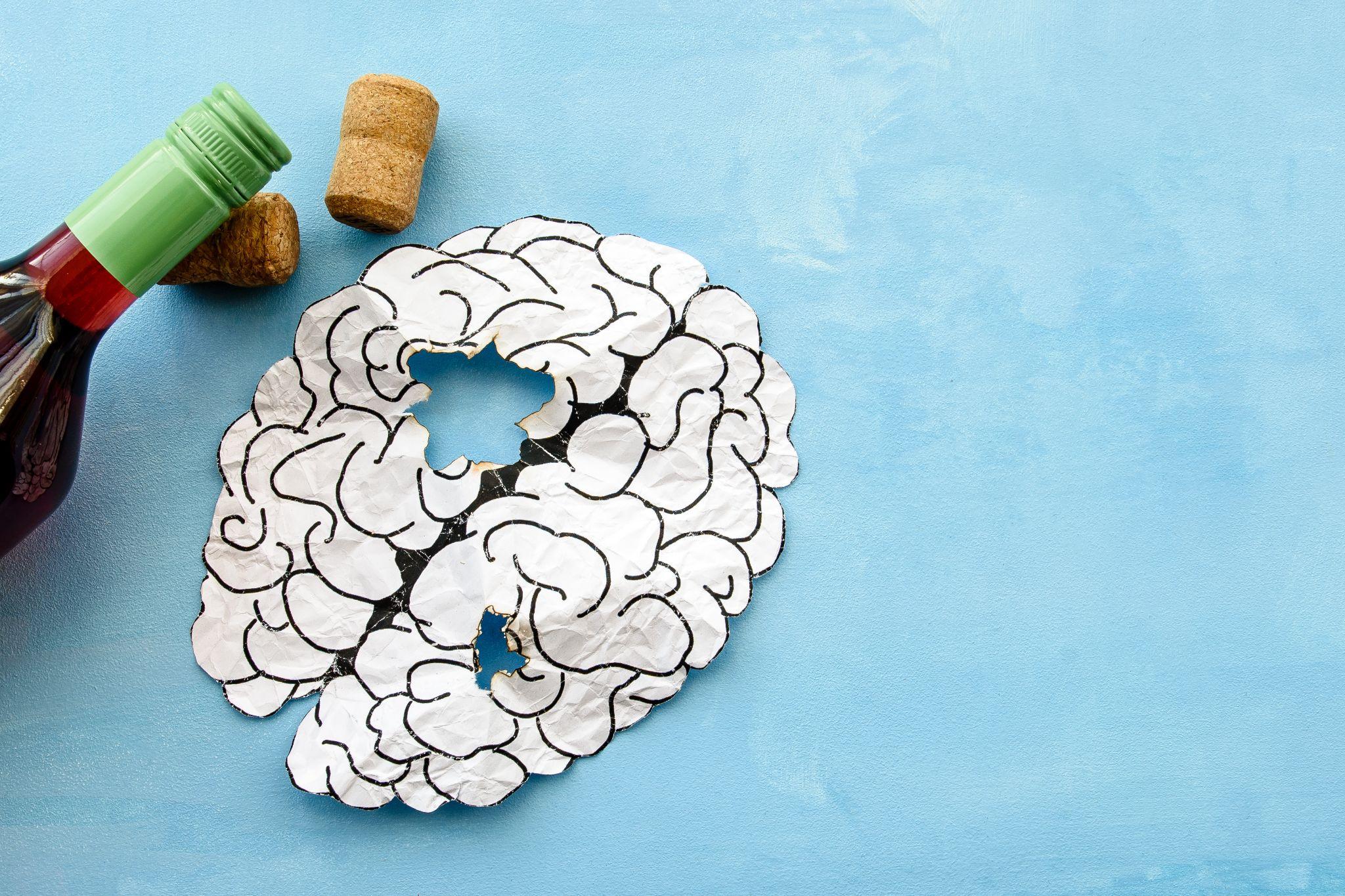
Our Addiction Resources
Navigating the world of addiction and recovery can be overwhelming. We’re here to provide clear, compassionate education and guidance. From practical advice for maintaining sobriety to informational guidance on the long-term effects of substance abuse, our content is a beacon of hope and understanding.
Our Team is Ready are ready to take your call
Call us Today!
or we can call you. Fill out form below
Our Blog

The Link Between Alcohol and Sleeplessness
Insomnia is a common issue that affects many individuals, often resulting in difficulty falling or staying asleep. Alcohol, while sometimes used as a temporary sleep aid, can actually exacerbate sleep problems over time. Understanding the relationship between alcohol and sleeplessness is crucial for addressing and improving sleep quality.
What Is Insomnia?
Insomnia is a sleep disorder that involves chronic difficulties with falling asleep, staying asleep, or getting restorative sleep.
Insomnia can be categorized into two types:
- Acute Insomnia: Short-term insomnia, often caused by stress or significant life changes, that typically resolves on its own.
- Chronic Insomnia: Long-term insomnia that persists for a month or longer and often requires intervention.
Symptoms of insomnia include:
- Trouble falling asleep at night
- Frequent waking overnight
- Waking up too early (and struggling to fall back asleep)
- Feeling tired after waking
- Daytime sleepiness or fatigue
- Irritability, depression, or anxiety
- Difficulty concentrating or remembering things
Insomnia can have profound effects on daily functioning and overall health, making it essential to identify and address its causes. Even minor sleeplessness can add up over time, causing serious problems. It can make you feel tired, affect your mood, and lower your productivity, gradually harming your health and well-being. Addressing these sleep issues as soon as possible can help prevent bigger health problems.
How Does Alcohol Affect Your Sleep Cycle?
Alcohol works as a central nervous system depressant, which means it slows down brain activity. When you drink, it increases the effects of a calming brain chemical called GABA. This makes you feel relaxed and sleepy at first. Many people think this will help them sleep better, but it actually causes problems later on.
As the initial effects wear off, the body begins to process the alcohol, which can cause disruptions in sleep. This can lead to waking up during the night and feeling less rested in the morning. These disruptions can manifest in various ways, including the following:1,2
Disrupted Sleep Stages
Alcohol interferes with the natural progression of sleep stages, particularly REM (rapid eye movement) sleep, which is crucial for mental restoration. Reduced REM sleep can lead to impaired cognitive function and mood disturbances.
Frequent Awakenings
As alcohol is metabolized during the night, it leads to fragmented sleep. This results in lighter sleep stages and frequent awakenings, particularly in the second half of the night. This interruption prevents you from getting restful and restorative sleep.
Breathing Issues
Alcohol relaxes the muscles in the throat, which can exacerbate breathing problems such as sleep apnea and snoring. These issues further disrupt sleep and can lead to daytime fatigue.
Increased Urination
Alcohol is a diuretic, meaning it increases the production of urine. This can cause individuals to wake up multiple times during the night to use the bathroom, disrupting sleep continuity.
How to Sleep Better Without Alcohol

If you’re struggling with sleeplessness or insomnia, it’s important to seek solutions that don’t involve alcohol. Here are eight effective strategies you can use to improve sleep quality without turning to addictive substances:
1. Establish a Consistent Sleep Schedule
Keeping roughly the same sleep schedule helps to regulate the body’s internal clock. Go to bed and wake up at the same time every day, including weekends. This consistency reinforces healthy sleep patterns.
2. Create a Relaxing Bedtime Routine
Help your body recognize when it’s time for sleep by creating a relaxing ritual that you follow the same way every night. Calm activities like taking a soothing bath, meditating, practicing deep breathing, or reading a book can help promote better sleep.
3. Optimize Your Sleep Environment
Ensure your bedroom is conducive to sleep. This includes keeping the room cool, dark, and quiet. Invest in a comfortable mattress and pillows, and eliminate any sources of light and noise.
4. Avoid Stimulants and Heavy Meals Before Bed
Don’t have caffeine, nicotine, or heavy meals close to bedtime. The stimulant chemicals and/or digestive response after eating can make it harder for your body to wind down. If you’re hungry, have a light snack instead.
5. Engage in Regular Physical Activity
Exercise can help improve sleep quality, but try to avoid vigorous activity close to bedtime. Aim for moderate exercise, such as walking or yoga, earlier in the day.
6. Manage Stress and Anxiety
Stress and anxiety are common contributors to insomnia. Practice stress-reducing techniques like mindfulness, meditation, or journaling. Seeking support from a therapist can also be beneficial.
7. Consider Natural Sleep Aids
Certain natural supplements, like melatonin or valerian root, may help promote sleep. However, it’s important to consult with a healthcare professional before starting any new supplement.
8. Monitor Light Exposure
Exposure to natural light helps regulate your sleep-wake cycle. Try to spend time outside or open the curtains during the daytime. In the evening, reduce exposure to bright screens to help signal to your body that it’s time to wind down.
End Alcohol Addiction and Sleep Better With Treatment From Lumina Recovery
At Lumina Recovery, we understand the complex relationship between alcohol and sleep. Alcohol addiction not only disrupts sleep patterns but also affects overall health and well-being. Our comprehensive treatment programs are designed to address the root causes of addiction and provide the tools needed for long-term recovery.
In our personalized, evidence-based treatment plans, individuals benefit from professional medically assisted detox, therapy, and holistic practices that promote healthy sleep habits and overall wellness.
Contact Lumina Recovery today to learn more about our alcohol addiction treatment programs and start your journey to recovery.
Sources:

Understanding Moderate Drinking: What It Really Means
Understanding what moderate drinking truly means is crucial for maintaining a healthy relationship with alcohol. Many individuals are misled by drinking culture, thinking their habits are moderate when they might be risky. Below, we aim to clarify what moderate drinking is, how cultural influences can distort perceptions, what alcohol addiction looks like, and how to seek help if needed.
What Is Moderate Drinking?
Moderate drinking refers to the consumption of alcohol within limits that are generally considered safe for most adults. According to the Centers for Disease Control and Prevention (CDC), moderate drinking is defined as up to one drink per day for women and up to two drinks per day for men.1
A standard drink in the United States is defined by the CDC as:2
- 5 ounces of wine (12% alcohol content)
- 12 ounces of beer (5% alcohol content)
- 8 ounces of malt liquor (7% alcohol content)
- 5 ounces of distilled spirits (40% alcohol content)
These amounts can help individuals gauge their alcohol intake and ensure they stay within the limits of moderate drinking. However, it’s crucial to note that these guidelines are not universal. Factors such as age, health conditions, and medications can influence how alcohol affects an individual.
The Influence of Drinking Culture
Drinking culture plays a significant role in shaping our perceptions of what is considered moderate or excessive drinking. In many societies, social events and gatherings often center around alcohol, making it easy to overlook or underestimate consumption levels. Advertisements, media, and social norms can glamorize heavy drinking, leading to a skewed perception of moderation.
For example, social events might encourage continuous drinking over several hours, often leading to consumption that exceeds moderate drinking limits. Peer pressure and the desire to fit in can further exacerbate this issue, making it challenging to adhere to moderate drinking guidelines.
Moreover, certain cultural practices and celebrations may normalize heavy drinking, leading individuals to believe that their drinking habits are moderate. Understanding these cultural influences is essential for recognizing when drinking habits may be veering into risky territory.
The Risks of Exceeding Moderate Drinking
While moderate drinking is usually considered safe, exceeding these limits can pose significant health risks. Understanding these risks is crucial for making informed decisions about alcohol consumption.
Physical Health Risks
Excessive drinking can lead to numerous physical health problems, including:
- Liver Damage: Heavy drinking can cause liver diseases such as fatty liver, hepatitis, and cirrhosis.
- Heart Disease: High alcohol intake can lead to high blood pressure, cardiomyopathy, and increased risk of heart attack and stroke.
- Cancer: Alcohol consumption has been linked to an increased risk of throat, mouth, colon, liver, and breast cancers.
Mental Health Risks
Excessive alcohol consumption can also have a detrimental impact on mental health, including:
- Depression and Anxiety: Alcohol can exacerbate or contribute to mental health disorders.
- Cognitive Impairment: Long-term heavy drinking can lead to memory problems and other cognitive deficits.
- Addiction: The risk of developing alcohol use disorder increases with higher levels of consumption.
What Alcohol Addiction Looks Like
When drinking exceeds moderate levels, it can lead to alcohol addiction, also known as alcohol use disorder (AUD). AUD is characterized by an inability to control drinking despite negative consequences. Recognizing the signs of alcohol addiction is crucial for seeking timely help.
Signs of alcohol addiction include:
- Craving alcohol and experiencing a strong urge to drink
- Inability to limit the amount of alcohol consumed
- Developing a tolerance, requiring more alcohol to achieve the same effect
- Experiencing withdrawal symptoms such as nausea, sweating, or shaking when not drinking
- Neglecting responsibilities at work, school, or home due to drinking
- Continuing to drink despite problems caused or worsened by alcohol
Knowing When You’ve Crossed the Line
Recognizing these signs in yourself and admitting that you have crossed the line from drinking moderately into addiction is a challenge. For those in denial, it’s easy to downplay or rationalize habits, finding ways to frame their behaviors as different from the typical signs.
If you’re the one experiencing it, alcohol addiction can look and feel like:
- Frequent thoughts about drinking
- Prioritizing alcohol over other needs and wants
- Needing to drink more to achieve the same effect as before
- Starting drinking earlier in the day
- Stashing alcohol around the house or taking it with you on outings
- Being unable to truly enjoy yourself at an event without getting a drink
Moving past denial involves being honest with oneself, listening to concerns from loved ones, and understanding that seeking help is a sign of strength, not weakness.
How to Seek Help

Getting help for an alcohol addiction is the best way to end the cycle and protect a person’s health. The first step is acknowledging that there is a problem. From there, various treatment options are available, ranging from medical detoxification and inpatient rehabilitation to outpatient counseling and support groups.
Here are some steps to consider:
- Consult a Healthcare Professional: A doctor can assess the extent of the alcohol use disorder and recommend appropriate treatment.
- Explore Treatment Options: Treatment can include inpatient or outpatient rehab programs, counseling, and medication to help manage withdrawal symptoms and reduce cravings.
- Join Support Groups: Groups such as Alcoholics Anonymous (AA) provide a supportive community for individuals seeking to overcome alcohol addiction.
- Build a Personal Support Network: Family and friends can play a crucial role in providing emotional support and encouragement throughout the recovery process.
Get Compassionate Alcohol Addiction Treatment at Lumina Recovery
At Lumina Recovery, we understand the complexities of alcohol addiction and the challenges that come with seeking help. Our team of dedicated professionals is here to provide comprehensive care tailored to your unique needs. We offer a range of treatment options designed to support you on your journey to recovery, including medically assisted detox, therapy, and aftercare planning.
Don’t let alcohol addiction control your life. Reach out to Lumina Recovery today and take the first step towards a healthier, more fulfilling future.
Contact us today to learn more about our alcohol addiction treatment programs and how we can help you achieve lasting sobriety.
Sources:

Can You Reverse Brain Damage From Alcohol?
Alcohol consumption can have profound effects on the brain, both in the short and long term. While moderate drinking might not cause significant harm, chronic and excessive alcohol use can lead to severe brain damage.
How Alcohol Affects the Brain
Alcohol affects the brain by disrupting its normal functions. When you drink, alcohol quickly reaches your brain and causes problems.There are several ways that alcohol can affect brain function and structure:1,2
- Neurotransmitter Disruption: Alcohol can mess with brain chemicals, slowing down brain activity and affecting thinking and coordination.
- Cell Damage: Long-term drinking can create harmful free radicals that damage and kill brain cells.
- Inflammation: Alcohol can trigger inflammation in the brain, harming cells and disrupting connections.
- Nutritional Deficiencies: Heavy drinking can often lead to a lack of important vitamins, like thiamine, causing serious brain disorders.
- Brain Shrinkage: Continuous alcohol use can shrink important brain areas, leading to cognitive and functional issues.
Together, these kinds of physiological effects can significantly change the structure and chemistry of the brain, significantly impacting a person’s ability to think, remember things, and perform everyday tasks. Severe brain damage may even lead to problems with other bodily systems, leading to worse and worse health.
The Brain Disease Model of Addiction
The brain disease model of addiction explains that addiction is a long-term brain disease that changes how the brain works. This helps us understand why people with alcohol use disorder (AUD) can’t control their drinking, even when it causes problems. Over time, drinking changes the brain’s reward system, making it hard to feel pleasure without alcohol and leading to compulsive drinking.
The Impact of Alcohol-Related Brain Damage
Alcohol-related brain damage (ARBD) can greatly affect a person’s health and life, impacting both physical and mental well-being.
Cognitive Impairments
- Memory Loss: Long-term drinking can cause problems with both short-term and long-term memory, making it hard to remember recent events or learn new things.
- Poor Judgment and Decision Making: Alcohol can damage the brain’s prefrontal cortex, leading to poor decision-making and risky behavior.
- Difficulty Adapting: People may struggle to adapt to new situations or solve problems effectively.
Motor Function and Coordination
- Balance and Coordination Problems: Alcohol can damage the cerebellum, causing balance issues and poor coordination, which increases the risk of falls and injuries.
- Impaired Fine Motor Skills: Precision tasks, like writing or buttoning a shirt, can become difficult due to reduced fine motor skills.
Psychological and Behavioral Effects
- Mood Disorders: Chronic alcohol use can lead to depression, anxiety, and other mood disorders, exacerbating the cycle of addiction.
- Personality Changes: Individuals may exhibit changes in personality, such as increased irritability, aggression, or apathy.
- Social and Professional Life: ARBD can strain relationships, affect job performance, and lead to social isolation.
Health Impacts
- Problems in other areas of the body: Because the brain controls all bodily systems, brain damage may increase risks of issues like liver disease, cardiovascular problems, and a weakened immune system.
- Wernicke-Korsakoff Syndrome: This severe disorder, caused by a deficiency of thiamine (vitamin B1), is common in chronic alcohol users. It includes symptoms like confusion, memory loss, and coordination problems.
- Alcoholic Dementia: Chronic alcohol abuse can lead to a type of dementia characterized by severe memory loss and cognitive decline.
- Hepatic Encephalopathy: Liver damage from heavy drinking can lead to a buildup of toxins in the brain, causing confusion, mood changes, and impaired cognition.
Factors Influencing Recoverability of Brain Damage From Alcohol
Fortunately, it’s possible to reverse some alcohol-related brain damage. However, not all brain damage is equal. There are several factors that influence whether a person’s brain damage can be reversed, as well as how much they will be able to recover.
Severity and Duration of Alcohol Use
The longer and more heavily an individual has been drinking, the more extensive the brain damage is likely to be, making recovery more challenging.
Age and Overall Health
Younger individuals with better overall health have a higher likelihood of recovery compared to older adults with additional health complications.
Supportive Interventions
Access to medical treatment, nutritional support, and rehabilitation services plays a crucial role in the recoverability of brain damage.

How to Reverse Brain Damage From Alcoholism
When the brain is given the chance to recover from alcoholism, it begins to heal and rebuild itself. New brain cells are formed, and neuroplasticity allows the brain to create new connections to replace damaged ones. Reduced inflammation allows damaged cells to repair, and important vitamins and minerals replenish. As neurotransmitter levels stabilize, cognitive functions, mood, memory, and coordination gradually improve.
While complete reversal of severe brain damage may not always be possible, there are a few steps you can take to help improve brain function and promote healing.3
1. Get Help to Stop Drinking
The first and most crucial step in reversing brain damage is to stop drinking alcohol. Seeking professional help through detoxification and rehabilitation programs can provide the necessary support for quitting alcohol.
2. Nutritional Support
Proper nutrition, including supplements for vitamins and minerals such as thiamine, can help repair and regenerate brain cells. A balanced diet rich in antioxidants, healthy fats, and essential nutrients supports brain health.
3. Cognitive Rehabilitation
Engaging in cognitive rehabilitation programs using techniques like cognitive behavioral therapy (CBT) and neurofeedback, can help improve cognitive functions and rewire the brain’s pathways.
4. Physical Exercise
Regular physical exercise helps to promote the growth of new brain cells, and it generally helps improve overall brain function. Activities like aerobic exercises, yoga, and strength training can be beneficial.
5. Mental Stimulation
Keeping the brain active through mental stimulation, such as puzzles, reading, learning new skills, and engaging in social activities, can enhance cognitive recovery.
Get Help for Alcohol Addiction With Rehab at Lumina Recovery
At Lumina Recovery, we understand the complexities of alcohol addiction and its effects on the brain. Our comprehensive alcohol addiction treatment programs provide the essential support and healthcare needed to recover from both alcoholism and any related brain damage. Our personalized treatment plans include medical detox, nutritional support, cognitive rehabilitation, medication-assisted treatment and other holistic therapies, ensuring each client receives the specialized care they need.
Reach out to Lumina Recovery today to discover how we can help you end your dependence on alcohol and begin healing your brain and body.
Sources:

Meth Sores Explained
Methamphetamine, commonly known as crystal meth or meth, is a highly addictive and powerful stimulant that affects the central nervous system. The effects of meth use have significant physical and mental health consequences, among the most visible signs of meth abuse are meth sores.
These sores can be alarming for both users and their loved ones. Understanding what meth sores are, their causes, dangers, and how to heal them is important for those affected by meth addiction and their loved ones.
What Are Meth Sores?
Meth sores are open wounds, lesions, or blisters that appear on the skin of methamphetamine users. These sores are often painful and can become infected if not properly treated. They are one of the most recognizable symptoms of meth use and addiction.
The drug itself causes severe dehydration and dry skin, making the skin more prone to cracking and injuries. Methamphetamine also raises body temperature and blood pressure, which can cause excessive sweating. When combined with poor hygiene, this can create an ideal environment for bacteria and infections, leading to sores.
What Do Meth Sores Look Like?
Meth sores can vary in appearance but generally start as small red or white bumps. These bumps may be mistaken for pimples or insect bites. Over time, these bumps can turn into open wounds or ulcers.
Common areas where meth sores appear include the face, arms, and legs. They often become larger and more severe due to constant scratching or picking at the skin. This behavior is known as “meth mites” or “crank bugs,” where users feel like bugs are crawling under their skin.1
What Causes Meth Sores?
Several factors contribute to the development of meth sores:
- Skin picking. One of the primary causes of meth sores is a condition called formication, where meth users experience the sensation of insects crawling under their skin. This sensation leads to intense scratching and picking at the skin, causing sores and wounds. The constant scratching can break the skin, creating open wounds that can easily become infected.
- Poor hygiene. Meth users typically neglect personal hygiene, which increases the risk of infections and sores. The drug’s intense stimulant effects can lead users to go days without proper washing or care, allowing bacteria to thrive on the skin. This neglect, combined with open wounds from scratching, creates a perfect storm for the development of sores.
- Reduced blood flow. Meth constricts blood vessels, reducing blood flow to the skin and impairing the body’s ability to heal minor cuts and abrasions. This vasoconstriction means that any small injury or sore takes much longer to heal than it would in a healthy individual. Additionally, reduced blood flow can lead to tissue damage, exacerbating the severity of sores.
- Nutritional deficiencies. Meth addiction often leads to poor nutrition, weakening the immune system and skin health. Users may neglect to eat properly or consume a balanced diet, resulting in deficiencies in essential vitamins and minerals that are crucial for skin repair and overall health. Nutritional deficits can make the skin more fragile and less able to recover from damage.
What Are the Potential Dangers of Meth Sores?
Meth sores are not just unsightly—they pose significant health risks:
Infections
Open sores are prone to bacterial and skin infections, which can lead to severe complications if left untreated. Infections can spread to other parts of the body, causing systemic issues. Common bacteria that infect meth sores include Staphylococcus aureus and Streptococcus pyogenes. These infections can result in cellulitis, abscesses, and even sepsis, a life-threatening condition where the infection spreads into the bloodstream.2
Scarring
Repeated picking and poor healing can result in permanent scarring, which can affect a person’s appearance and self-esteem. Deep, chronic sores that repeatedly get infected or are not allowed to heal properly can leave behind significant scars.
Bloodborne Diseases
Sharing needles or other paraphernalia can transmit bloodborne diseases like HIV and hepatitis. Open sores increase the risk of these infections. When meth users share needles, they are at high risk of contracting and spreading these serious diseases.
Chronic Pain
Infected and inflamed sores can cause chronic pain and discomfort, further complicating recovery efforts. The persistent pain from untreated or poorly managed sores can be debilitating. This pain can interfere with daily activities, sleep, and overall quality of life, making it harder for individuals to focus on their recovery and maintain sobriety.

How to Heal Meth Sores
Healing meth sores requires a combination of medical treatment, proper hygiene, and lifestyle changes. Some steps to help heal these sores include:
Seek medical attention. It’s essential to see a healthcare professional for proper diagnosis and treatment. They can prescribe antibiotics for infections and recommend appropriate wound care. In severe cases, a doctor may refer the patient to a specialist, such as a dermatologist or an infectious disease expert, to manage complicated sores and infections effectively.
Stop using meth. The most effective way to heal meth sores is to stop using methamphetamine. Seek help from addiction specialists and consider enrolling in a rehabilitation program. Treatment options include inpatient and outpatient programs, counseling, support groups, and medication-assisted treatment. Quitting meth is crucial for the overall health and well-being of the individual, and it allows the body to begin the healing process.
Maintain proper hygiene. Clean the sores regularly with mild soap and water. Avoid picking at the sores to prevent further damage and infection. Regularly washing the affected areas helps remove dirt, bacteria, and dead skin, which can promote healing. Keeping the skin clean and dry is essential in preventing new sores from forming and existing ones from worsening.
Eat nutritiously and stay hydrated. Adequate hydration and a balanced diet promote overall health and can facilitate the healing process. Vitamins and minerals, especially vitamin C and zinc, are crucial for skin repair. A balanced diet can strengthen the immune system and provide the necessary nutrients for skin regeneration. Staying hydrated helps maintain skin elasticity and supports the body’s natural healing mechanisms.
Cover the sores. Keeping the sores covered with sterile bandages can protect them from bacteria and reduce the temptation to scratch. Bandaging the sores, as well as using over-the-counter or prescription ointments, also creates a barrier that helps keep the wounds clean and moist, which can promote faster healing. Change bandages regularly and follow proper wound care practices to prevent infection and encourage recovery.
Start Healing and Recovering With Lumina Recovery
Meth sores are a severe and visible consequence of methamphetamine addiction. Recovery from meth addiction and the associated physical damage is challenging, but with the right medical care and support, healing is possible.
Lumina Recovery offers specialized inpatient and outpatient treatment centers for meth addiction, providing personalized care and support to help individuals achieve long-term recovery.
If you or someone you care about is battling meth addiction, seek assistance today to begin the path toward recovery and healing.
Sources:

What Is an Aftercare Plan in Addiction Recovery
After completing addiction treatment, ongoing support is crucial for long-term success. An aftercare plan in addiction recovery provides a structured approach to maintaining sobriety and preventing relapse. Aftercare planning includes various strategies and resources tailored to an individual’s needs, ensuring continuous support. By addressing both the physical and emotional aspects of recovery, aftercare plans help individuals build a strong foundation for a healthier future.
Effective addiction treatment aftercare often involves counseling, support groups, and lifestyle changes, helping individuals navigate their new, sober lives. These programs address challenges that arise after treatment and provide a safety net for those in recovery. Additionally, aftercare services can adapt to changing needs over time, offering flexibility and personalized care to enhance recovery outcomes. Participating in aftercare programs can significantly boost the chances of maintaining long-term sobriety and reduce the likelihood of relapse.
Lumina Recovery Offers a Continuum of Care
At Lumina Recovery, we offer a continuum of care, ensuring our clients receive comprehensive support throughout their recovery journey. Our inpatient rehab programs equip patients with essential tools for successful recovery, while our outpatient treatment options provide continued support as they transition back to daily life.
Partnering with sober living facilities, Lumina Recovery ensures individuals have access to ongoing care and support. Our strong alumni network further enhances this support by offering peer connections, shared experiences, and a sense of community that extends well beyond initial treatment.
Below, we’ve created a quick visual guide to help you better understand what aftercare is and why it’s so important.


Doctor Shopping: An Addiction Red Flag
Addiction can manifest in various ways. Some of which may not be immediately obvious to the casual observer. One such behavior is “doctor shopping.” This term refers to the practice of visiting multiple healthcare providers to obtain prescriptions for controlled substances, often without the doctors knowing about each other.
Recognizing the signs of doctor shopping is crucial for both those dealing with addiction and their concerned loved ones.
What Is Doctor Shopping?
Doctor shopping involves a person consulting several doctors to obtain multiple prescriptions for drugs, often opioid prescriptions or other controlled substances.
This practice is usually done to bypass regulations that limit the amount and frequency of prescribed medications. Doctor shoppers may give false information about their symptoms or withhold information about other prescriptions from physicians to obtain the drugs they desire.
Why Do People Doctor Shop?
There are several reasons why individuals engage in doctor shopping:
The most common reason is an addiction to prescription medications. When one doctor refuses to prescribe more drugs or limits the dosage, the individual seeks out other doctors to fulfill their needs. Addiction is a mental illness and drives people to go to great lengths to obtain the substances they crave.
Some people seek pain management for chronic pain and may not get adequate relief from a legitimate prescription, leading them to seek additional prescriptions. They might feel that their pain is not being taken seriously or that they need more medication than is being prescribed to manage their symptoms effectively.
Those dependent on these medications may go to great lengths to avoid withdrawal symptoms by visiting multiple doctors. Withdrawal from certain medications can be severe and distressing, prompting individuals to take desperate measures to prevent it.
In some cases, individuals obtain prescriptions to sell the medications illegally for profit. The black market for obtaining controlled substances can be lucrative, and some people engage in doctor shopping as a means of income, contributing to the wider issue of drug abuse and the opioid epidemic in the community.
Mental health problems such as anxiety, depression, and other disorders can drive individuals to misuse prescription drugs as a form of self-medication. They may doctor shop to maintain a steady supply of medication to manage their mental health symptoms, often exacerbating the individual’s condition in the process.
Dangers of Doctor Shopping
Doctor shopping is a dangerous practice with several significant risks:
Risk of addiction. Continually obtaining and using prescription drugs over a period of time can deepen an individual’s substance use disorder, making it harder to break the cycle of addiction. The more they use, the more they need to achieve the same effects, leading to an escalating pattern of substance abuse.
Possible overdose. Taking multiple prescriptions from different doctors can lead to accidental drug overdoses. The lack of coordinated care means there is no single provider monitoring the total amount of medication being consumed. Combining different medications, especially those that depress the central nervous system, significantly increases the risk of a fatal overdose.
Legal issues. Doctor shopping is illegal and can result in severe legal consequences, including fines and imprisonment. It is considered fraud and is punishable under the law. Getting caught can lead to a criminal record, which can have long-lasting effects on a person’s life, including employment opportunities and personal relationships.
Health risks. Misusing prescription medications can cause a range of health issues, from liver damage to heart problems, depending on the drugs involved. Long-term abuse can result in chronic health conditions that may not be reversible.

How to Stop Doctor Shopping
Stopping doctor shopping requires an approach that addresses both the behavior and the underlying addiction.
The first step to stopping doctor shopping is acknowledging that there is a problem. This self-awareness can be a turning point for many individuals. Recognizing the issue is essential for taking the necessary steps toward recovery.
In some cases, family members or friends may need to stage an intervention to help the individual recognize their problem. A compassionate and non-judgmental approach can encourage the person to accept help.
Seeking help from addiction specialists is crucial. These professionals can provide tailored treatment programs that address the specific needs of the individual. They can offer medical, psychological, and social support.
A single healthcare provider can coordinate care, monitor the patient’s medication use, and adjust treatments as necessary. This approach reduces the risk of over-prescription and ensures safe medication practices.
Mental health treatment can help individuals who engage in doctor shopping to self-medicate underlying mental health issues. Addressing these issues through therapy and appropriate medication management can reduce the compulsion to seek multiple prescriptions.
For those dealing with chronic pain, exploring alternative pain management options such as physical therapy, acupuncture, or non-opioid medications can reduce reliance on prescription drugs.
What to Do If You Suspect Your Loved One Is Doctor Shopping
If you suspect that someone you care about is doctor shopping, there are several steps you can take:
Educate yourself. Learn about the signs and risks of doctor shopping to better understand the situation. Recognizing the behavior and understanding its implications can help you provide informed support and intervention.
Communicate appropriately. Approach your loved one with compassion and concern. Express your worries without judgment and offer your support. Open, non-judgmental communication is crucial. Avoid accusatory language that might lead to defensiveness. Instead, focus on expressing your concern for their well-being and your desire to help them find a healthier path.
Encourage professional help. Suggest seeking help from a healthcare professional or an addiction treatment center. Offer to help them find resources and accompany them to appointments if needed. Providing tangible support, such as helping them research treatment options or offering to go with them to appointments, can make the daunting process of seeking help feel more manageable.
Monitor and support. Keep an eye on their behavior and medication use. Provide ongoing support and encouragement throughout their recovery process. Consistently checking in and offering emotional and practical support can make a significant difference. Encourage healthy habits and positive activities that can help them stay focused on recovery.
Seek Support for Long-Term Recovery With Lumina Recovery
Doctor shopping is a serious red flag of addiction that can have devastating consequences. Whether you are struggling with addiction or are concerned about a loved one, recognizing the signs and taking proactive steps is essential.
Lumina Recovery’s inpatient, outpatient, and sober living options provide a wide range of care to fit your needs. With the right support and resources, it is possible to overcome this dangerous practice and work towards a healthier, addiction-free life.
Take the first step towards a healthier future by addressing doctor shopping today.

Why Some People Relapse Multiple Times
Relapsing during the journey of addiction recovery can be a disheartening experience, both for the person struggling with addiction and their loved ones. It’s important to understand that the relapse cycle is often part of the recovery process.
While some people manage to achieve long-term recovery after initial treatment for substance use disorders, others find themselves going through the stages of relapse multiple times before they can maintain lasting recovery. Knowing why this happens can help demystify the process and offer hope and encouragement to those affected.
What Is Relapse?
Relapse refers to the return to substance use after a period of abstinence. It’s a common occurrence in the cycle of addiction. Studies suggest that 40-60% of people recovering from addiction will relapse at least once. For some, this is a temporary setback, while for others, it becomes a recurring pattern.1
Repeated relapse can be frustrating and demoralizing. It may seem like a sign of failure, but it’s important to view it as a part of the recovery journey rather than an endpoint. Each relapse can offer valuable lessons and insights that contribute to eventual long-term sobriety.
6 Possible Causes of Repeated Relapse
Relapse from substance abuse can be influenced by a variety of factors, ranging from unaddressed underlying issues to environmental triggers.
By examining these causes, we can better understand the challenges faced by those struggling with repeated relapse and find more effective ways to support loved ones on their journey to lasting sobriety. Here are some of the most common reasons for repeated relapse:
1. Unaddressed Underlying Issues
Often, alcohol or drug addiction is a symptom of deeper underlying issues such as trauma, mental health disorders, or chronic stress. These issues can create a persistent emotional and psychological environment where substance use becomes a coping mechanism.
If these underlying issues remain unaddressed, the risk of relapse increases significantly. Comprehensive treatment plans that include therapy for these conditions can be crucial. For instance, cognitive behavioral therapy (CBT) can help individuals recognize and change negative thought patterns that contribute to substance use.
2. Environmental Triggers
Being in environments where drug or alcohol use is prevalent or encountering people who encourage substance use can trigger cravings and relapse. These triggers can be physical places, like bars or certain neighborhoods, or social interactions with people who use substances.
Managing these triggers often requires significant lifestyle changes. This may involve avoiding certain social circles, finding new hobbies, or even relocating to a different area. Developing a strong plan to manage and avoid these triggers is essential for maintaining sobriety.
3. Lack of Coping Skills
Life inevitably includes stress, anxiety, and other negative emotions. Without effective coping strategies, individuals may turn to substances as a way to cope. Learning and practicing healthy coping mechanisms through therapy can help reduce the risk of relapse.
Techniques such as mindfulness, stress management strategies, and emotional regulation skills can be highly beneficial. Engaging in regular physical activity, practicing relaxation techniques like deep breathing or meditation, and seeking support through counseling can all be part of building a robust set of coping skills.
4. Inadequate Support Systems
Support from family, friends, and support groups plays a significant role in recovery. Without a strong support system, individuals may feel lonely and more likely to relapse. Emotional support and accountability can make a significant difference.
Engaging in community support groups like Alcoholics Anonymous (AA) or Narcotics Anonymous (NA) can provide crucial encouragement and a sense of belonging. Additionally, family therapy sessions can help rebuild trust and establish a supportive home environment.
5. Overconfidence
Some people may become overconfident in their ability to resist substances after a period of sobriety. This can lead to risky behaviors, such as socializing in environments where substance use is common.
Overconfidence can create a false sense of security, leading individuals to believe they can handle exposure to triggers without relapsing. Maintaining a humble and cautious approach to recovery is important. Regularly attending support meetings and continually working on one’s relapse prevention plan can help keep overconfidence in check.
6. Biological Factors
Genetic predispositions and changes in brain chemistry due to prolonged substance use can put some individuals at a higher risk of relapse. Addiction can alter the brain’s reward and stress systems, making it more difficult to resist cravings.
Understanding these biological factors can help tailor more effective, personalized treatment plans. Medications like buprenorphine, naltrexone, suboxone, and methadone can be part of a comprehensive treatment plan, helping to manage cravings and stabilize brain chemistry.

The Emotional Impact of Repeated Relapse
Experiencing repeated relapses can lead to feelings of shame, hopelessness, and frustration. It’s common for individuals to question their ability to achieve lasting recovery. Loved ones may also feel helpless and discouraged.
Recognizing these emotional impacts and addressing them through counseling and support groups is crucial. Rebuilding self-esteem and finding hope again is an essential part of the recovery process.
The stigma surrounding relapse can exacerbate these negative emotions, making individuals feel isolated and judged. This isolation can create a vicious cycle where the person struggling with addiction turns to substances to cope with their feelings of shame and despair.
It’s important for both the individual and their support network to approach relapse with compassion and understanding. Open communication, reassurance, and professional support can help break this cycle, allowing the person to regain confidence and stay committed to their recovery journey.
Stay Hopeful and Avoid Relapse With Lumina Recovery
If you or a loved one are struggling with repeated relapses, it’s important to remember that you are not alone and that relapse does not mean failure. Each setback is an opportunity to learn more about the addiction and to refine the approach to recovery.
Feeling hopeless and frustrated is natural, but remember that recovery is a journey. Every step, including the setbacks, brings you closer to lasting sobriety. Stay encouraged, seek help, and believe in the possibility of a brighter, healthier future.
Lumina Recovery offers holistic addiction treatment services for a wide array of drug types, providing personalized care tailored to each individual’s unique needs.
Reach out for support and take the next step towards a healthier, sober life.
Sources:

The Postpartum Depression and Addiction Connection
Postpartum depression is a serious condition that affects many new mothers, often leaving them feeling overwhelmed, anxious, and disconnected from their baby.
When combined with the pressures and responsibilities of motherhood, this mental health challenge can sometimes lead to substance use disorders as a means of coping.
Understanding the relationship between postpartum depression and addiction is crucial for recognizing the signs and seeking the appropriate help for oneself or a loved one.
What Is Postpartum Depression?
Postpartum depression (PPD) is a type of depression that occurs after childbirth. Unlike when women experience “baby blues,” which typically resolve within a few days, symptoms of postpartum depression include more severe and long-lasting challenges.
Mothers with postpartum depression symptoms can face intense sadness, fatigue, irritability, anxiety, and trouble bonding with the baby. It affects not only the mother but also the overall well-being of the family.1
The Relationship Between Postpartum Depression and Addiction
The relationship between postpartum depression and addiction is complex. Pregnant women have intense emotional and physical demands, coupled with hormonal changes, that can lead to feelings of isolation and despair.
Some mothers, especially women with a history of substance abuse, may turn to alcohol, prescription medications, or illicit drugs to self-medicate their overwhelming emotions and physical exhaustion.
These substances can provide temporary relief in the postpartum period but often result in a cycle of dependency, further complicating their mental health and overall well-being.
The stigma and shame associated with co-occurring postpartum depression and addiction can prevent mothers from seeking help, exacerbating their struggles. Understanding this connection is necessary for recognizing the signs and encouraging mothers to seek the professional support they need.
Drugs Commonly Abused by Those Suffering From Postpartum Depression
Mothers who experience postpartum depression may abuse a variety of substances in an attempt to manage their symptoms:2
- Alcohol abuse in women, often used for its sedative effects, can temporarily numb emotional pain but ultimately exacerbate depression. It is widely accessible and socially acceptable, making it a common choice for self-medication. Mothers might consume or binge drink alcohol to relax or unwind after a stressful day, but over time, this can lead to dependence and increased depressive symptoms.
- Some mothers may misuse prescription drugs like benzodiazepines or opioids, seeking relief from anxiety or physical discomfort. Benzodiazepines, prescribed for anxiety or sleep disorders, can be habit-forming and lead to dependence if not used as directed. Opioids, often prescribed for pain relief, can also be misused to escape emotional pain, leading to addiction.
- Illicit drugs such as marijuana, cocaine, and methamphetamine might be used to escape reality or boost energy levels. Marijuana is sometimes perceived as a way to relax or reduce anxiety, but it can also impair cognitive function and exacerbate depressive symptoms. Cocaine and methamphetamine addictions can temporarily increase energy and mood but come with severe health risks and a high potential for addiction.
Why Some Mothers Self-Medicate
The reasons why some mothers self-medicate during postpartum depression can vary:
Desperation for relief. The intense emotional and physical symptoms of PPD can drive mothers to seek immediate relief through substances. The overwhelming nature of postpartum depression often leaves mothers feeling like they have no other options. The immediate, albeit temporary, relief that substances provide can be very appealing when facing constant emotional pain and exhaustion.
Stigma and shame. Fear of judgment or stigmatization may prevent mothers from seeking professional help, leading them to self-medicate instead. Society often places unrealistic expectations on new mothers, expecting them to be perfectly happy and competent. This can create a sense of shame for those experiencing PPD, making them reluctant to reach out for help and instead turn to substances in secrecy.
Lack of support. Without a strong support system, mothers may feel isolated and overwhelmed, increasing the temptation to use substances as a coping mechanism. Many mothers do not have access to a network of family and friends who can offer emotional and practical support. This isolation can intensify feelings of depression and anxiety, driving them to seek solace in substances.

5 Reasons for Mothers to Seek Help
Recognizing the signs of postpartum depression and addiction is the first step toward recovery. Seeking help is crucial for several reasons:
- Health and Safety: Both PPD and substance abuse can have serious health implications for the mother and her child. Professional help ensures that both receive the care they need. Untreated PPD can lead to long-term mental health issues, and substance abuse can result in addiction, health problems, and impaired ability to care for the child.
- Breaking the Cycle: Without staging an intervention, the cycle of addiction and depression can continue, affecting the mother’s ability to care for her child and herself. Addiction and depression often feed into each other, creating a vicious cycle. Treatment can offer strategies and different forms of therapy to help mothers manage their depression without resorting to substance abuse. This can ultimately lead to a healthier and more stable lifestyle.
- Building a Support System: Treatment provides access to support groups, therapy, and medical care, helping mothers build a network of support and develop healthy coping strategies. Support groups can offer a sense of community and understanding, reducing feelings of isolation. Therapy can provide tools and techniques to manage depression and prevent relapse into substance abuse.
- Mother and Child Bonding: Seeking help can improve the mother’s mental health, allowing her to better bond with and care for her baby. The early months of a child’s life are crucial for bonding and development. A mother who is struggling with PPD and addiction may find it challenging to connect with her baby. Treatment can help mothers overcome these challenges, fostering a stronger, healthier relationship with their child.
- Long-Term Well-Being: Addressing both PPD and addiction early can lead to better long-term outcomes for the mother and her family. Early intervention can prevent the progression of both conditions, reducing the risk of long-term mental health issues and substance dependency. This proactive approach can lead to a more fulfilling and balanced life for the mother, positively impacting her entire family.
Get Support for Postpartum Depression and Addiction With Lumina Recovery
Postpartum depression and addiction are serious, interlinked issues that require understanding and compassionate intervention. Recognizing the symptoms, understanding the reasons behind self-medication, and seeking professional help can help mothers find the support they need to heal and thrive.
Lumina Recovery offers dual diagnosis services, addressing both depression and various addiction types, to provide holistic and effective treatment for individuals facing these intertwined challenges.
Don’t wait to seek the help you deserve—connect with our team of specialists for a healthier future for you and your baby.
Sources:

What Is an Emotional Relapse?
Understanding addiction recovery from drugs or alcohol involves recognizing various types and stages of relapse. Among these, emotional relapse is one of the most subtle yet impactful stages.
Knowing what emotional relapse is, how to prevent it, recognizing signs, and providing steps to take if you find yourself in an emotional relapse are essential for recovery from substance abuse. Our guide is meant to help individuals in recovery and their loved ones navigate this complex aspect of addiction.
Defining Emotional Relapse
Emotional relapse is a phase in the recovery process where an individual’s emotional and mental state begins to deteriorate, potentially triggering a physical relapse.
Unlike physical relapse, which is characterized by the act of returning to substance use, emotional relapse is more about internal struggles that may not be immediately visible.
During this stage, a person may experience a resurgence of negative emotions and behaviors that were present during active addiction.
How to Prevent Emotional Relapse
Preventative strategies for avoiding emotional relapse involve proactive measures to maintain emotional and mental well-being. Here are some strategies that can help:
- Self-Care Practices: Taking care of your physical health directly impacts your emotional health. Ensure you get adequate sleep, eat a balanced diet, and engage in regular physical activity. Self-care supports emotional stability, making it easier to manage stress and negative emotions.
- Mindfulness and Meditation: Practicing mindfulness and meditation can help you stay present and aware of your emotional state. These practices teach you to observe your thoughts and feelings without judgment, allowing you to respond to them in a healthy way rather than reacting impulsively.
- Therapy and Counseling: Regular sessions with a therapist or counselor provide a safe space to explore and address emotional challenges. Cognitive behavioral therapy (CBT) and other therapeutic approaches can help you develop coping strategies and emotional resilience.
- Support Networks: Engaging with support groups or recovery communities can provide a sense of belonging and reduce feelings of isolation. Sharing your experiences with others who understand can offer valuable insights and encouragement.
- Routine and Structure: Having a daily routine and structure can provide stability and predictability, which are essential for managing stress and anxiety that can trigger a relapse. Plan your day with regular activities, including time for self-care, work, new sober hobbies, and social interactions.
- Journaling: Writing about your thoughts and feelings can help you process and understand them better. Journaling can also be a tool to track your emotional state and identify patterns that might indicate an impending emotional relapse.
- Developing Emotional Awareness: Pay attention to your emotional triggers and responses. By understanding what situations or thoughts lead to negative emotions, you can develop strategies to manage them before they escalate.
- Setting Boundaries: Establish clear boundaries in your relationships and daily life. Knowing your limits and communicating them effectively can prevent you from feeling overwhelmed and stressed.
8 Signs You Might Be Experiencing an Emotional Relapse
Recognizing the warning signs of emotional relapse early can prevent a downward spiral into physical relapse of drinking or using drugs. Some common indicators are:
- Mood Swings: Experiencing unpredictable changes in mood, from high to low, without any clear cause. These mood swings can leave you feeling out of control and may lead to emotional instability.
- Isolation: Withdrawing from social interactions and preferring to be alone. This can manifest as avoiding friends, family, and support group meetings. Isolation often leads to feelings of loneliness and can make it harder to manage stress and negative emotions.
- Anxiety and Stress: Persistent feelings of anxiety and stress that don’t subside. You might feel overwhelmed by daily tasks or responsibilities, leading to increased tension and worry.
- Anger and Irritability: Feeling unusually angry or irritable without a significant trigger. Small annoyances can lead to intense frustration, and you may find yourself lashing out at others or feeling constantly on edge.
- Neglecting Self-Care: Skipping meals, not sleeping well, or ignoring personal hygiene. Self-care is crucial for emotional health, and neglecting it can lead to further emotional decline.
- Denial: Refusing to acknowledge that you might be struggling emotionally. You might dismiss your feelings or convince yourself that everything is fine, even when it’s not.
- Obsessive Thoughts: Becoming preoccupied with negative thoughts or past events. This can lead to a cycle of rumination, where you continuously think about things that upset you, making it difficult to move forward.
- Loss of Interest: Losing interest in activities or hobbies that you once enjoyed. This can be a sign of underlying emotional distress and can contribute to feelings of emptiness or boredom.

What to Do If You’re in an Emotional Relapse
If you recognize that you’re in an emotional relapse, it’s essential to take immediate action and have a relapse prevention plan to prevent further decline. Here’s what you can do:
- Reach out for help. Contact a trusted friend, family member, or sponsor who understands your situation. Talking to someone who can offer support and perspective can be incredibly helpful.
- Seek professional support. Schedule an appointment with your therapist or counselor to discuss your feelings and get professional advice. Therapeutic approaches can provide you with strategies to manage your emotions and prevent a physical relapse.
- Engage in recovery activities. Attend support group meetings or recovery workshops to reconnect with your recovery goals. Being around others who understand your journey can provide a sense of community and encouragement.
- Practice self-compassion. Be kind to yourself and acknowledge that setbacks are a part of the recovery journey. Remember that it’s okay to feel overwhelmed sometimes, and give yourself permission to seek help and take a step back when needed.
- Develop a coping plan. Work with your therapist to develop a plan to manage your emotions and stress effectively. This might include specific strategies for dealing with triggers, relaxation techniques, or activities that help you feel grounded.
Take Control of Your Emotional Health With Lumina Recovery
Emotional relapse is a critical stage in the recovery process that requires attention and proactive management. With the right strategies and support systems in place, overcoming emotional relapse is entirely possible, paving the way for a healthier, more stable recovery journey.
Lumina Recovery’s team of addiction recovery specialists is here to help you or a loved one through residential inpatient and outpatient programs at any stage of the recovery process.
Reach out now for support and take proactive steps to ensure a stable and healthy recovery journey.
Additional Resources
Once you have completed your rehabilitation program at one of our drug and alcohol treatment centers, you should try to surround yourself with people who can encourage you to stay sober. Many people find that support groups are the best source of encouragement. You can find hundreds of support groups and meetings in your community. Our drug addiction treatment centers stress the importance of personal chemical dependency resources, especially when you are new to sobriety. Below are various addiction and mental health resources for people in recovery who want additional support.
Christian Addiction Recovery Resources
Our substance abuse services aren’t limited to specific programs, but rather we believe in the importance of incorporating faith-based programs to promote spiritual healing, like our Faith in Recovery program.
With that said, below are some faith-based addiction recovery resources that could help you in your spiritual healing from addiction:
- Battlefield of the Mind by Joyce Meyer
- Boundaries by Dr. Henry Cloud & Dr. John Townsend
- Christian Families in Recovery: A Guide for Addiction, Recovery, and Intervention Using God’s Tools of Redemption by Robert and Stephanie Tucker
- Club New Life Christian Ministry for Addiction and Recovery
- Lost & Found: Recovery in Christ by Bruce Stanley
- Overcoming Emotional Obstacles through Faith: Navigating the Mind Field by Anthony Acampora, Director of Banyan’s Faith in Recovery Program
- The Case for Christ by Lee Strobel
Mental Health Resources for Recovery
Lumina Recovery consist of both mental health and substance abuse treatment facilities, meaning we offer mental health resources as well as chemical dependency resources. What’s more, addiction often co-occurs with mental illness, making these resources ever more important.
Below are some resources for mental health recovery that can help you or your loved one:
- This Emotional Life video series
- No Kidding, Me 2!! with Joe Pantoliano
- Dare: The New Way to End Anxiety and Stop Panic Attacks by Barry McDonagh
- Pleasure Unwoven: An Explanation of the Brain Disease of Addiction by Kevin McCauley
- Declutter Your Mind: How to Stop Worrying, Relieve Anxiety, and Eliminate Negative Thinking by S.J. Scott and Barrie Davenport
Call Us Today – (877) 716-7515

